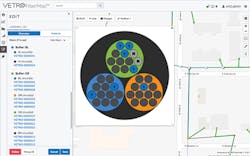Fiber Network Documentation Planning —
Demand for bandwidth is doubling every 100 days. In fact, the Fiber Broadband Association estimates that 5G will require the deployment of about 1.4 million miles of fiber in just the top 25 urban areas in the United States. To effectively capitalize on this demand, Internet service providers (ISPs) need to deploy or expand their networks quickly and efficiently. The bottleneck? Asset documentation and management.
Accurate network documentation is crucial to going to market faster; it outlines current connections, maps existing infrastructure, and provides a clear view of available network capacity, which helps identify the best routes for expansion. This remote visibility improves operational efficiencies by reducing the need for expensive field maintenance tasks such as truck rolls, enabling ISPs to be more cost-competitive overall. Robust documentation also empowers ISPs to assign an accurate valuation to the network if they are considering an acquisition or sale, and makes it easy to package network data to meet funding, regulator or third party compliance requirements.
InvisiLight® Solution for Deploying Fiber
April 2, 2022Go to Market Faster. Speed up Network Deployment
April 2, 2022Episode 10: Fiber Optic Closure Specs Explained…
April 1, 2022Food for Thought from Our 2022 ICT Visionaries
April 1, 2022Historically, network asset inventory was managed in static CAD files that were difficult to update and share. As a result, the documentation was often incomplete or outdated, which required engineers to spend valuable time confirming true network connectivity information through field audits.
Today, there are several more dynamic geospatial environments that provide visibility across departments and enable data access and sharing. However, a few planning steps are necessary before choosing to migrate your data. These 5 guidelines will help get you started.
Guideline #1. Set Clear Goals
Before making any decisions, it’s important to determine what’s most integral to your network’s success. For instance, are you
• Expanding, selling, or acquiring, a network?
• Trying to reduce operational costs?
• Working to improve customer support response rate?
• Reducing organizational risk or dependence on institutional knowledge?
Determining where you’d like to end up will help you figure out where to start.
Analytics portal view of fiber network capacity.
Guideline #2. Get Organized
Take an inventory of your current assets. Collect all existing records of fiber paths, materials and equipment across your entire network, and try to digitize them to the best of your ability. For instance, any paper records should be converted to digital files for easier management.
When possible, it’s preferable to convert data into a shapefile or .kmz format. CAD files tend to be more complicated to ingest into a new system because they’re not necessarily GIS-friendly.
In addition, the network data in CAD files is often offset from the physical infrastructure, and must be corrected by manually aligning fiber routes with existing infrastructure to ensure spatial accuracy.
Fiber assignment within the buffer tube.
Guideline #3. Determine Functionality Requirements
There are several potential software solutions to compare when selecting your ideal geospatial environment for your network data, so it helps to narrow down your criteria. Here are a few things to consider.
• How many people will need access to your network map and data, and in what capacity?
• Will you hire specialists or contractors to manage the software, or will you train existing employees?
• Are you currently working on a fixed timeline for any new fiber deployment?
• Will you require integration with software such as OSS/BSS, CRM or field data collection tools?
• Are you considering demand aggregation tools to expedite customer acquisition?
• Are there existing processes you’d like to automate or simply improve?
• Do you need to include field images of your physical network assets in your inventory?
• Do you need to speed up deployment or network repairs with more intuitive field work orders and splicing diagrams?
Guideline #4. Consider On-Premise vs. Cloud Hosting
As the popularity of open and connected cloud-based software grows, ISPs have an increasing number of questions about data security. While cloud-based hosting can seem less secure, it actually provides equal if not better data redundancy.
On-premise or single-stack solutions typically rely on the IT department to perform backups, which can be inconsistent or incredibly proactive, depending on your team. On the other hand, cloud-based hosting provides redundancy by performing automatic updates that store data on multiple servers.
Another added benefit: unlike static desktop single-stack software, cloud-based solutions never go out of date — all new features and upgrades are automatically synced to your account.
Like this Article?
Subscribe to ISE magazine and start receiving your FREE monthly copy today!
Guideline #5. Get Started
You’re now well on your way to having a complete representation of the physical network, from the switch to the customer, that allows you to evaluate or adjust your network at any level.
Now that you’ve identified your goals, organized your existing inventory, and figured out what you need from an asset management solution, it’s time to start evaluating specific software.
While we are admittedly biased toward the VETRO FiberMap platform solution, our team is happy to act as a resource and to answer any questions that arise as you evaluate geospatial fiber management solutions. Good luck, and happy splicing!
About the Author






